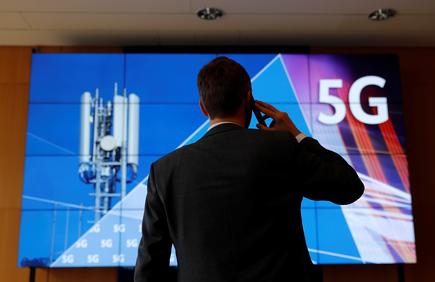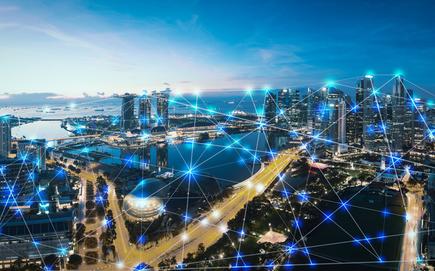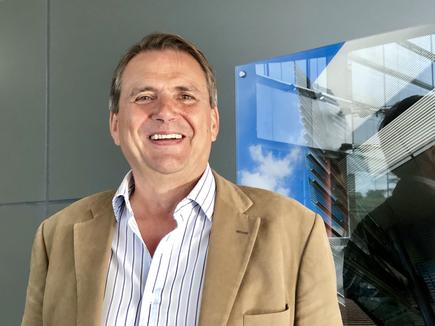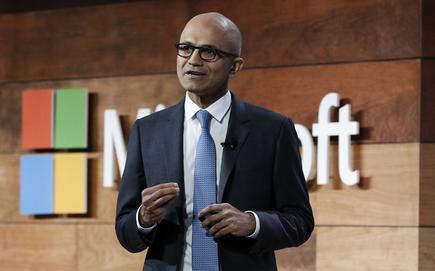
People are crying out for good, well-led change
Mike Stone has led massive business programmes involving complex changes across sectors, including technology, government, and telecommunications.
Some programmes, however, stand out than most for Stone, now global head of technology transformation for infrastructure, government and healthcare at KPMG.
Prior to joining the advisory firm, Stone was chief digital information officer at the UK Ministry of Defence (MOD).
It was 2014 and he embarked on a massive ‘Defence as a Platform’ programme, that entailed moving into systems into the cloud and embracing big data and analytics, according to Stone.
He asked the CEOs of their three major technology providers - Fujitsu, Microsoft and HP - “to sign in blood” that they were going to help deliver the programme.
“I explained to them the era of monolithic big contracts are coming to an end,” he says. “But we will deliver the most complex implementation of Office 365 anywhere in the world.”
“In transformation, if there is a will, there is a way,” states Stone, as a key lesson from this experience.
“You always hear the phrase ‘change fatigue’,” he says. “I don’t think there is such as thing.”
“There is ‘bad change fatigue’, that people are crying out for good” - and this he says with emphasis - “well-led change.”
He adds that, “What happens normally with big change programmes is most of them don’t deliver.
“That is why people say there is change fatigue. You have got to maintain clarity of what you are seeking to do; part of it is getting people to question why, and empower them in a new way."
 Credit: Supplied
Credit: Supplied A lot of people think China is miles ahead in 5G. That is not the truth
Tales from the frontline
Stone joined the corporate sector in 2002 after retiring from the British Army.
He moved to a succession of executive roles including CEO of Defence Business Services, CEO of the MOD’s Information Systems and Services organisation, Group EVP and Chief Client Officer of Mastek, President Service Design and CIO of BT Global Services, COO of BT International, and CEO of BT OpenAccess.
“I am at heart someone who gets my hands dirty,” says Stone, who spoke at a forum for graduates of the CIO programme at the University of Auckland Business School.
“I couldn't see another role that would give me an opportunity to move out of my comfort zone,” he explains, on his decision to join KPMG more than two years ago.
He was the chief digital information officer at the Ministry of Defence from 2014 to 2017.
Today, he works with KPMG clients across the globe on optimising their transformation programmes through the use of technology.
At the University of Auckland forum and in an interview with CIO New Zealand, he outlines approaches on leading transformation programmes that can work across sectors.
Recalling his three years at the UK MOD, he says,“It was a very big and demanding role.”
He had control of structures, policies, procedures, acquisition, and delivery of technology in different areas, as well as information, risk and cyber.
He was responsible, among others, for all desktop services, in the barracks, in the office, out in the field, to a thousand locations worldwide, and “at every level of classification you can possibly think of.''

There isn’t a startup in the Valley that is not cloud-based, and that does not deliver everything to mobile devices
Truisms on leading through change
He looks at these responsibilities across a set of truisms.
The first is that information and data “is the lifeblood of any operation.”
“This is pertinent in defence, but also in any organisation,” he adds.
According to him, an organisation may have a different nervous system, “but if you do not have the information, the data, to enable you to make rapid decisions, you are at a big disadvantage.”
“I am a great believer in the key role of the CIO is to enable the business to be successful, and they should be providing the business with the tools they need to exploit their data.”
His second mantra is that, “Just about all transformation these days is either driven by, or enabled by technology, or it delivers technology. Transformation is about technology.”
The third is around the pace of change. “Innovation is ever accelerating.”
With these three truisms, he says leaders should also be aware of what is coming over the horizon from a technology perspective.
“If I understand what is coming into the horizon, I can prepare my organisation to be able to respond to it appropriately and at the right pace.”
Stone discloses that this is one of the reasons why for the past two decades, he has been going to Silicon Valley at least once a year.
“Making that trip is an absolute must for me, even if I am busy,” to ensure he is keeping abreast of trends. He also schedules regular trips to other centres of innovation such as Israel, Prague and London.
He singles out themes that stand out during these trips: cloud, mobility, augmented intelligence, Internet of Things, robotics, and augmented reality.
He says the cloud already has winners in the space, with Microsoft and AWS reaping billions of dollars a quarter from the cloud.
He explains that 10 years ago, a really good organisation that grew fairly organically would take at least 10 years before they would operate outside their borders.
“These days, because of the cloud, they can be in a hundred countries overnight.”
He adds that, “There has been exponential change and as a result of that, there isn’t a startup in the Valley that is not cloud-based, and that does not deliver everything to mobile devices.”
He says the other technology themes also capitalise on cloud and mobility.
Augmented intelligence, he explains, refers to a family of startups around big data, peer to peer, cognitive intelligent automation.
“It is almost you will not get funding unless you have a natural language processing capability in your business case.”
The next one is a whole group of things around information assurance, information security, privacy, and cyber.
“Blockchain fits in there,” he says, but adds, “I like to think blockchain is a solution looking for a requirement. And we are still absolutely not certain what are the requirements.”
Then, there is the Internet of Things. There are huge leaps in this space, he says, “but I would rather call it the ‘sensors of things’ because it is all about sensors.”
We are seeing huge leaps forward in terms of IoT in predictive maintenance, with sensors on bits of equipment, he states.
“Robotics and autonomous vehicles have also seen huge advances in industry,” he adds.
“There are other themes but these are the ones I think are the common core, that every organisation should be thinking about.”

I look at the gaming industry, particularly now that we are talking about digital twins
The most disruptive tech
He then looks through these trends through “the secure 5G lens”.
Stone believes the most disruptive technology in the horizon is 5G, not from a consumer, but an enterprise perspective.
He says 5G is revolutionary, and is not just the next evolution of 2G, 3G, and 4G.
“We are at the point of that first exponential leap forward with 5G, to doubling of things, 400 by 400; 160,000 by 160000, 26 billion by 26 billion,” he explains.
He points out that this is going to be enterprise led, not consumer-led.
A person being able to download a two-hour movie in three seconds is consumer, not enterprise use of 5G.
“The real driving factor for 5G is the ability to enable the sensors to intercommunicate and create a decision support fabric to you in relatively near real-time,” he says.
“I see 5G as being the fundamental underpinning of Industry 4.0,” he adds.
“We are entering the era of true hyper converged connectivity in which all sensors will be interlinked, and in due course, will be interlinked with humans, as well.”
Stone says telcos, in general, talk about 5G, from a consumer perspective.
“In many cases, what you see around the world with telcos when they talk about 5G is they are taking about ‘4-and a bit-G, not true 5G.”
He stresses that security is fundamental to 5G. He predicts the expansion of companies that will be able to protect 5G, as well as legacy systems in 3G and 4G.
The heart of the 5G ecosystem is data, he states.
“We don’t already make great use of data we have available now. Very few organisations are using more than 25 per cent of their data.”
“5G is going to unleash a new tsunami of data,” he states.
“But luckily, we have other technologies that are maturing at exactly the right time to be able to make better use of, and to make 5G itself more powerful but also that 5G will make them more powerful, as well.”
He notes that, “If you are milling a turbine blade, it takes 15 hours to do so. If there is an issue, you have to start again. With low level latency, sensors can sense a vibration that shouldn't be there in less than a millisecond and stop operation before it does damage. That is a huge impact in the industrial space.”
He further explains that 5G can support a million active connections in every square kilometre as opposed to a hundred thousand connections for 4G. 5G is a mesh network, which means it is autonomic and self-healing.
“It is a very different set of technology to its predecessors, so with that speed and capacity we can run huge amounts of augmented intelligence over it and to pass them later to provide near real-time (decision) support.”
The theme of 5G inevitably raises questions on geopolitics, specifically, the current discussion regarding the role of Huawei in national technology rollouts.
 Credit: Dreamstime
Credit: Dreamstime The key role of the CIO is to enable the business to be successful, and they should be providing the business with the tools they need to exploit their data
Stone cites, for instance, that President Donald Trump says the US will not share intelligence with countries that have Huawei in the 5G core.
“That is a decision you as a nation-state have got to do,” he states.
“A lot of people think China is miles ahead in 5G. That is not the truth. But it is a perception that could become a reality if the West does not act rapidly and decisively,” he states.
'Clearly, the issue of whether to source 5G equipment from Chinese companies requires consideration of geopolitical as well as security aspects,” he states.
“It is incumbent upon us all as leaders to be positioning ourselves around, what are you going to do to keep abreast of what your competitors are doing in this sphere so you are not disrupted?”
Gas and games
Stone says another initiative worth doing is to look at an industry outside one’s own.
“I am constantly looking to see what are the sectors that I can learn from. Is there something I can take for my own organisation?”
In his case, these were the oil and gas and online gaming industries.
“Oil and gas because they operate in similar hostile conditions to the military,” he says.
“We have similar information exchange requirements, from big gigabit pipes in the centre to small megabit pipes in the field. So how do you manage the exchange of information?”
The gaming sector is enormous, he says. “Clearly, this sector is of the here and now.”
“Kid are playing all these games. Is there a way for us to think about what we do as a game?”
“I looked at the gaming industry, particularly now that we are talking about digital twins.
“I have some very interesting assets that need to be protected,” he adds.
So during one of his trips to Silicon Valley, he met with the Improbable Gaming Company.
According to Stone, Improbable has created a compute fabric that if you change the behaviour of one entity, it changes the behaviour of every entity at every level.
“You could leave it at a point where there are millions of possible endings to the game.”
This has implications for business continuity planning, for instance, in an organisation’s assets.
“It is like having a sandbox to see what is the effect or impact of an event or an incident,” he explains.
“You can use that to model networks. If I have a lot of networks, it will allow me to have a sandbox feed of information of all my assets for real-time decision support.”
He adds that, “If I had a cyber event, I can track it and see where the implications are, and where I need to take action to prevent the contagion to come through.”
 Credit: shutterstock_794559286
Credit: shutterstock_794559286 “I always assume breach...That does not mean that you have been breached, but it forces you to think in a different way about security
The primacy of security
Security is a key theme across all transformation programmes.
“Most people focus on the perimeter, that is the least important part from my perspective.”
“I always assume breach,” he says. “That does not mean that you have been breached, but it forces you to think in a different way about security.”
As he shared on LinkedIn, “Organisations should operate on the assumption that their firewall has been breached and that there are people already inside the network who should not be there. So, then you must ask, what needs to be true for you to be ‘comfortable’ with uninvited guests inside your network?”
“Firstly, you need to be able to detect, contain and remove malicious software, or malware, as rapidly as possible.
“Secondly, if uninvited guests are still inside then you need to ensure that they can’t steal any information or that what they can exfiltrate is worthless, which is where digital rights management has a significant part to play.”
He tells CIOs at the University of Auckland Business School forum: “I would suggest you start with what are your crown jewels. What are the things I need to protect like IP and personal data?”
“The other thing about security is that the cloud is more secure than on premise, at least at scale,” he says.
“Microsoft and AWS spend more on security than I ever could,” he shares.
He then cites, “You need to protect yourself, there are things like the Patriot Act.”
The Defence as a Platform, for instance, provided horizontal technology platforms that enabled the business to do things, but with a design authority in place.
He says this means looking at things in three perspectives: Is it complying where we are going security wise? Is it coherent with the programme? Is there sufficient finance for it overall?
“And if the answer is yes, it goes through.”
Stone adds that, “If there were challenges we would meet that challenges, get that to people to put it in the proper workflow.”
He also told them, “I want you to ensure that if you are doing something that will be useful elsewhere, I can export it elsewhere, as well.”
This way, he says, you are enabling the business but also protecting the organisation from a security perspective.

If you don’t put people and culture at the heart of change programmes, you are going to fail
Culture in change management
He is frank about the “huge” cultural challenge in organisations undergoing change.
“I have driven change programmes in a range of organisations. If you don’t put people and culture at the heart of it, you are going to fail.”
When he was running the multi-billion pound programme at the MOD, Stone says he spent 80 per cent of his time in culture and people.
Fully 35 per cent of that 80 per cent was in “managing upwards”, he explains.
“In some of the organisations, it may be less, but a good chunk of your time needs to be focused on it.”
He says the managing part was also across government and making sure everybody was aware of what he was seeking to do.
“I was socialising the programme ahead of time,” he says.
“You have got to be able to create a story,” he advises. “I am a great believer in communications, and the first thing I invested in was building a communications team.”
He brought people across government and discussed with them the complexity of the organisation and the details of the transformation programme.
“It [the defence ministry] is a microcosm of government,” he points out. “We have doctors, nurses, firefighters, dentists, teachers, nuclear scientists, firefighters...you will have everything you will find in a small city.
“You have to make sure your peers buy into where you want to go.”
The issue is the “frozen middle”, he says, referring to middle management.
He notes that organisations can address this by telling them: “I am empowering you to ask the question why, why do we do it this way? Why can’t we do it this way?”
“I want you to be thinking about how to best challenge the organisation.”
“Give me those challenges and I will address those and take the barriers away from you,” he says. “Tell me about that and I will enable to do it in a different way.”
He also had regular coffee meetings and town hall discussions with groups of people around the business, “very much concentrating on the importance of asking the question why we were controlling things we had no need to control whatsoever.”
“The reason for it was lost in the mists of time,” he explains, “but people were comfortable doing it that way because that was the way we did it.”
Again, Stone states, on what works during a change programme: “Find the pain points and address them.”
He says “the most amazing thing” that happened during his term at the MOD was that they saved £4.8 billion pounds, and dealt with more demand in all of their areas, while reducing the size of his team by 20 per cent.
“We had a 5 per cent increase in staff engagement,” he adds. “Normally if you are asking fewer people to do more, you would have the opposite effect.”
Rebooting leadership
Asked to cite an organisation which provides great lessons on change management, he names one of the technology providers he worked with at Defence.
“The organisation that is going to have a case study for cultural change success is going to be Microsoft,” he says.
“I really admire what (Microsoft CEO) Satya Nadella has done,” he shares. “He fundamentally shifted the culture of the organisation in five years.”
“Five years ago, Microsoft had become really insular and were on the point of dropping out of the Fortune 10," says Stone.
“When Satya came in as CEO, he opened up Microsoft to the ecosystem and to open source,” he adds.
“He has transformed the company from one based around product silos to one based on customer cloud projects. He has focused his teams not on just selling software but on consumption of cloud and indeed, of licenses.
“To my mind it is the biggest cultural shift I have ever seen in a large organisation and I admire Satya for imbuing in his team a desire to deliver capabilities that benefit everyone on the planet,” says Stone.
Read more: 'Wizard' cybersecurity expert charged with record hack of Bulgarian tax agency
“If it can be done in Microsoft, it shows it can be done by any organisation.”
 Credit: Microsoft
Credit: Microsoft Looking over the tech horizon, the most disruptive is #5G: CIOs should ask: How do we position ourselves? What are we going to do to keep abreast in this sphere so we are not disrupted? @CIOMikeStone on #DX #Industry4.0 trends @AucklandUni CIO programme pic.twitter.com/pHtnyriDKL
— Divina Paredes (@divinap) July 2, 2019
Sign up for CIO newsletters for regular updates on CIO news, career tips, views and events. Follow CIO New Zealand on Twitter:@cio_nz
Send news tips and comments to divina_paredes@idg.co.nz @divinap
Join the CIO New Zealand group on LinkedIn. The group is open to CIOs, IT Directors, COOs, CTOs and senior IT managers.
